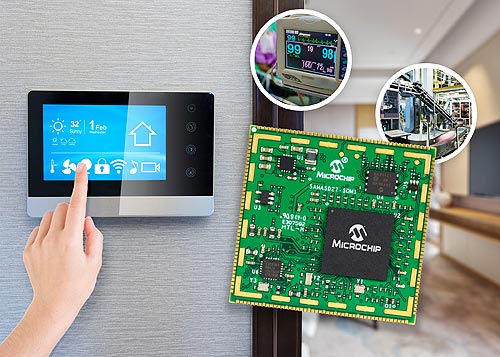 There is a great deal of design effort and complexity associated with creating an industrial-grade microprocessor (MPU)-based system running a Linux® operating system. Even developers with expertise in the area spend a lot of time on PCB layout to guarantee signal integrity for the high-speed interfaces to DDR memory and Ethernet Physical Layer (PHY) while complying with Electromagnetic Compatibility (EMC) standards. To remove the traditional design complexity in this space, Microchip Technology Inc. has unveiled a new System on Module (SOM) featuring the SAMA5D2 MPU. The ATSAMA5D27-SOM1, which contains the recently released ATSAMA5D27C-D1G-CU System in Package (SiP), greatly simplifies design by integrating the power management, non-volatile boot memory, Ethernet PHY and high-speed DDR2 memory onto a small, single-sided Printed Circuit Board (PCB). For more information visit: http://www.microchip.com/design-centers/32-bit-mpus/security
There is a great deal of design effort and complexity associated with creating an industrial-grade microprocessor (MPU)-based system running a Linux® operating system. Even developers with expertise in the area spend a lot of time on PCB layout to guarantee signal integrity for the high-speed interfaces to DDR memory and Ethernet Physical Layer (PHY) while complying with Electromagnetic Compatibility (EMC) standards. To remove the traditional design complexity in this space, Microchip Technology Inc. has unveiled a new System on Module (SOM) featuring the SAMA5D2 MPU. The ATSAMA5D27-SOM1, which contains the recently released ATSAMA5D27C-D1G-CU System in Package (SiP), greatly simplifies design by integrating the power management, non-volatile boot memory, Ethernet PHY and high-speed DDR2 memory onto a small, single-sided Printed Circuit Board (PCB). For more information visit: http://www.microchip.com/design-centers/32-bit-mpus/security
The SAMA5D2 family of products provides an extremely flexible design experience no matter the level of expertise. For example, the SOM—which integrates multiple external components and eliminates key design challenges around EMI, ESD and signal integrity—can be used to expedite development time. Customers can solder the SOM to their board and take it to production, or it can be used as a reference design along with the free schematics, design and Gerber files and complete bill of materials which are available online. Customers can also transition from the SOM to the SiP or the MPU itself, depending on their design needs. No matter which device a customer selects, all products are backed by Microchip’s customer-driven obsolescence policy which ensures availability to customers for as long as needed.
The ARM® Cortex®-A5-based SAMA5D2 SiP, mounted on the SOM PCB or available separately, integrates 1 Gb DDR2 memory, further simplifying the design by removing the high-speed memory interface constraints from the PCB. The impedance matching is done in the package, not manually during development, so the system will function properly at normal and low-speed operation. Three DDR2 memory sizes (128 Mb, 512 Mb and 1 Gb) are available for the SAMA5D2 SIP and optimized for bare metal, Real-time Operating System (RTOS) and Linux implementations.
Microchip customers developing Linux-based applications have access to the largest set of device drivers, middleware and application layers for the embedded market at no charge. All of Microchip’s Linux development code for the SiP and SOM are mainlined in the Linux communities. This results in solutions where customers can connect external devices, for which drivers are mainlined, to the SOM and SIP with minimal software development.
The SAMA5D2 family features the highest levels of security in the industry, including PCI compliance, providing an excellent platform for customers to create secured designs. With integrated ARM TrustZone® and capabilities for tamper detection, secure data and program storage, hardware encryption engine, secure boot and more, customers can work with Microchip’s security experts to evaluate their security needs and implement the level of protection that’s right for their design. The SAMA5D2 SOM also contains Microchip’s QSPI NOR Flash memory, a Power Management Integrated Circuit (PMIC), an Ethernet PHY and serial EEPROM memory with a Media Access Control (MAC) address to expand design options.
For additional information, contact any Microchip sales representative or authorized worldwide distributor, or visit Microchip’s website. To purchase products mentioned in this press release, go to Microchip’s easy-to-use online sales channel microchipDIRECT or contact one of Microchip’s authorized distribution partners.
Development Tools
The SOM1-EK1 development board provides a convenient evaluation platform for both the SOM and the SiP. A free Board Support Package (BSP) includes the Linux kernel and drivers for the MPU peripherals and integrated circuits on the SOM. Schematics and Gerber files for the SOM are also available.
Microchip Technology | www.microchip.com


